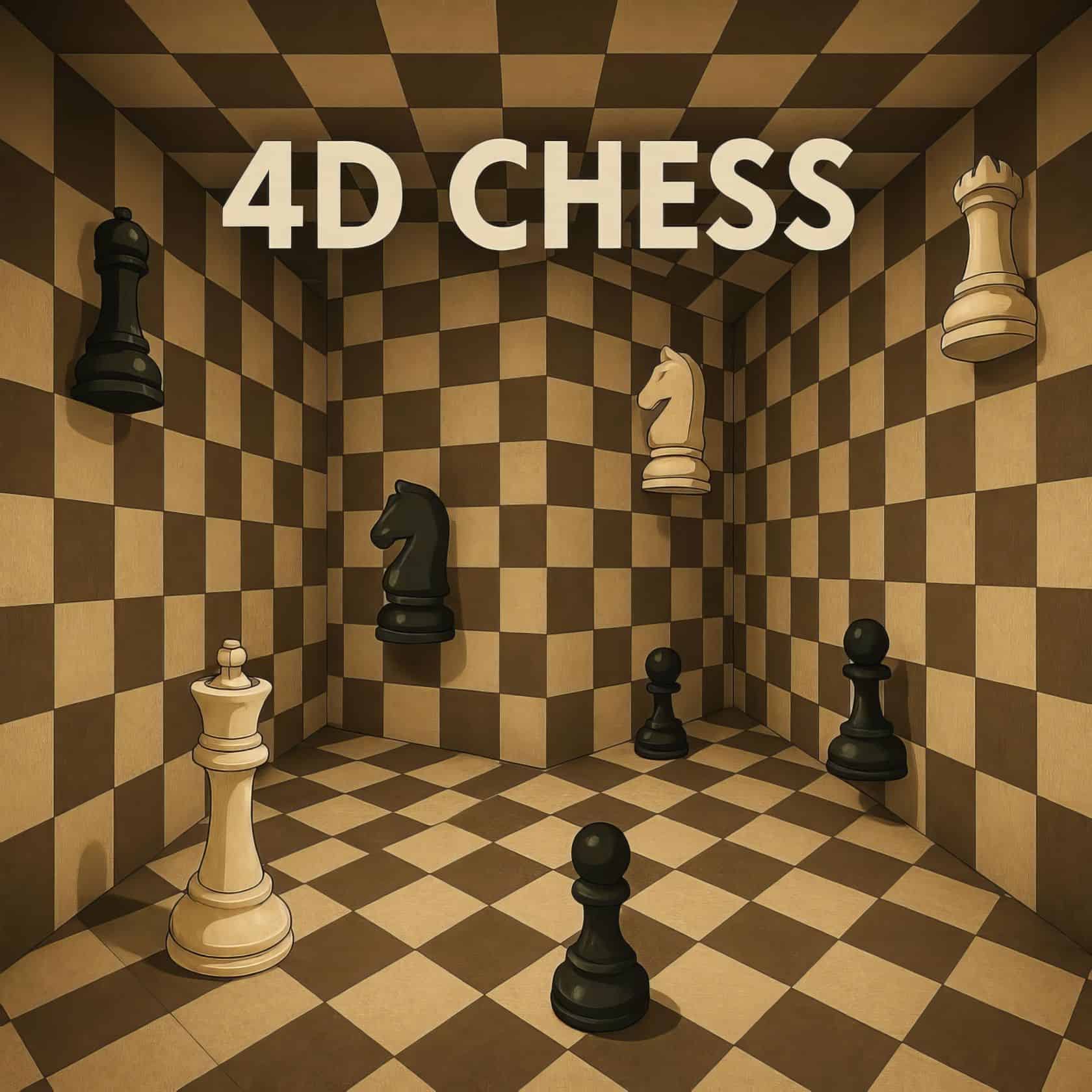Ever wondered “what is 4D chess” and how people play it? This advanced version of standard chess uses sixteen separate 4×4 mini-boards placed in rows and columns, adding a puzzling fourth dimension.
In this post, you’ll learn eight fascinating facts to help you understand the rules, tackle multi-dimensional moves, and sharpen your strategic thinking. Read on for gameplay secrets that might just boost your brainpower.
Key Takeaways
4D chess introduces time as its extra dimension—played on sixteen mini-boards (4×4 each), stacked into rows and columns.
Pieces gain new, unique moves across dimensions; queens now travel in 80 possible directions (up from 8), while knights leap freely between layers.
Politicians commonly use “playing 4D chess” as shorthand for describing deep, layered strategies at play in complicated situations.
Regular chess sharpens mental skills like recognizing patterns, forward planning, and memory; research links chess play directly to stronger math scores.
Real-world examples of physical 4D chess include Slim 4*Chess, a set featuring 80 detailed pieces, plus various digital versions—to make the abstract concept easier to grasp.
Table of Contents
What Is 4D Chess?
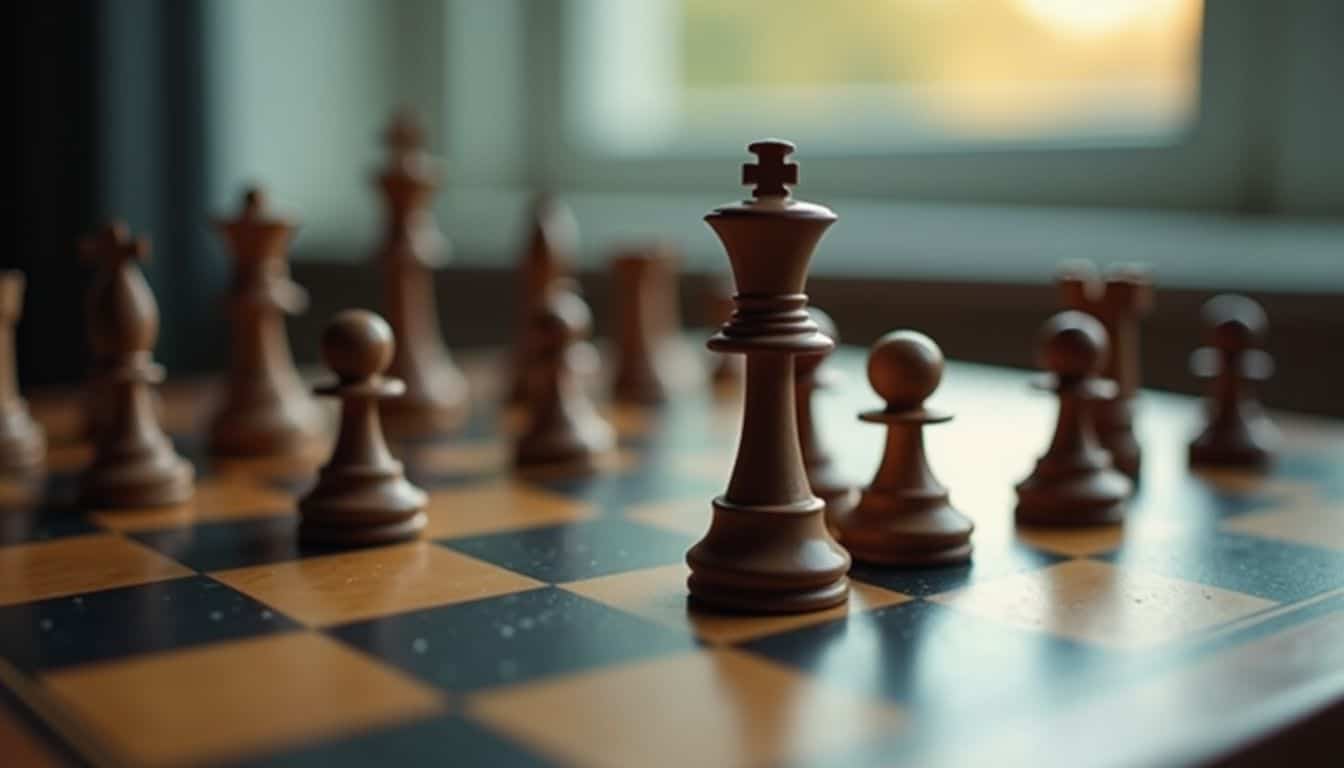
4D Chess takes the classic game into a whole new realm by adding time as the fourth dimension. Players must think about moves across multiple timelines, creating a brain-bending challenge that makes regular chess look simple.
Definition of 4D Chess

4D chess elevates the classic board game to a whole new dimension—literally. Instead of the standard 64-square chessboard, players use a mind-twisting hypercube board known as a tesseract.
This board contains 256 squares, allowing pieces to move not only forwards, backwards, left, and right—but also through an extra spatial dimension. Pieces like pawns, knights, and bishops traverse this added axis, making strategies far trickier than traditional chess.
Personally, I’ve spent hours tackling these unusual moves, and the learning curve feels like scaling a mountain while balancing chess pieces.
4D chess doesn’t just change the board—it transforms how you think about space itself.
Visualizing these moves is a real mental exercise, since they aren’t possible in normal physical spaces. In 4D chess, the rook can attack from angles you’d never imagine on a regular board.
The queen also becomes incredibly powerful, moving seamlessly across several planes at once. Although mostly theoretical, certain digital platforms let you actually try this four-dimensional puzzle on screen.
The game has gained enough popularity that the phrase “playing 4D chess” now describes people whose plans seem way ahead of everyone else, as in this piece on chess prodigy Andrea Botez.
The concept of the fourth dimension in chess
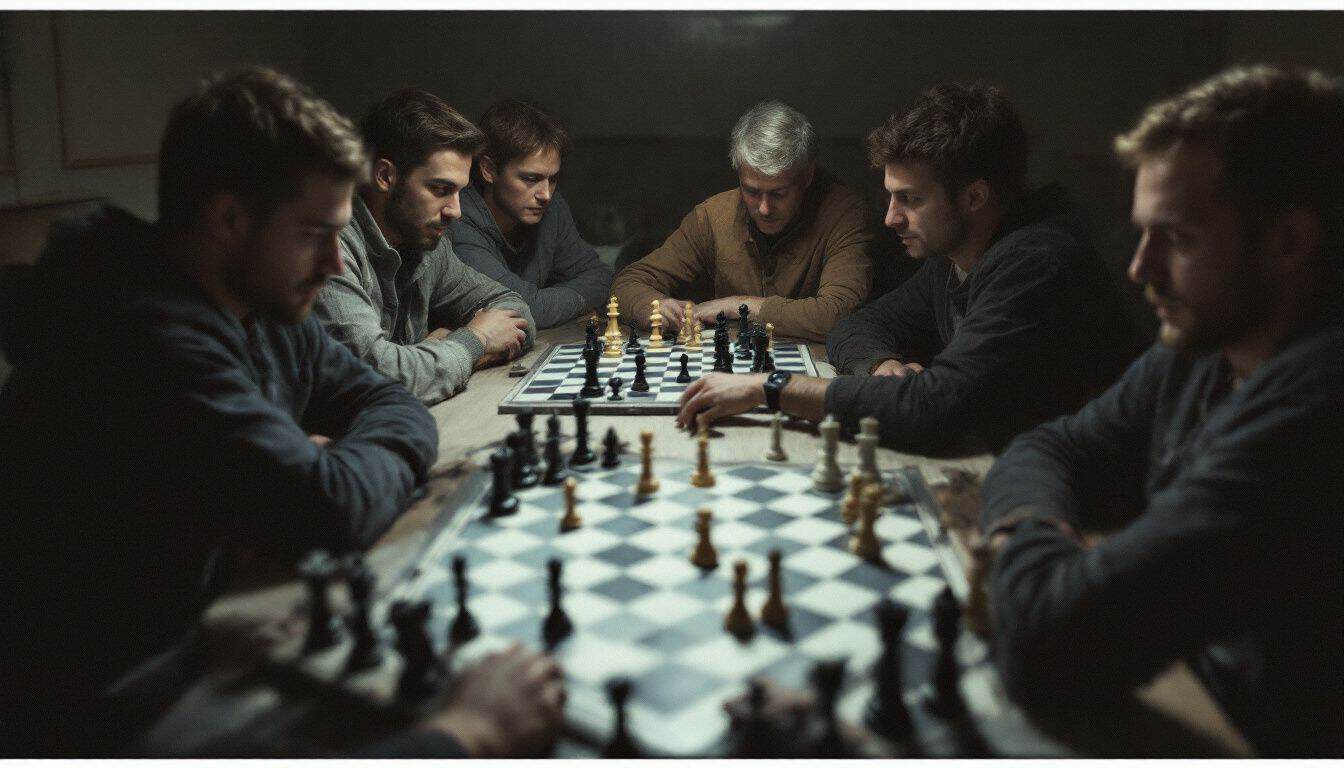
Chess with a fourth dimension adds an entirely fresh twist to the classic game you know and love. This extra dimension exists either as time—or as a spatial direction beyond normal 3D movement.
The board itself becomes a hypercube, arranged like a 4×4 grid of regular chessboards. With this layout, pieces—like knights, bishops, and rooks—can move between boards in surprising new ways.
I’ll never forget one game: my rook jumped across boards and took my friend’s queen, leaving him speechless, mouth wide open in disbelief!
The extra dimension opens up moves you wouldn’t expect in standard chess. Consider how a knight normally moves—making an L-shaped leap. Now picture the knight jumping across boards to a spot entirely separate from its starting point.
Pawns gain unique promotion possibilities, and kings suddenly face checkmates from totally unexpected directions. Visualizing moves in 4D chess can be incredibly tough—far more challenging than regular, or even 3D chess.
Players must track positions across all the boards at the same time, transforming a friendly strategy game into an intense puzzle that pushes your spatial thinking skills to the limit.
How Does 4D Chess Work?
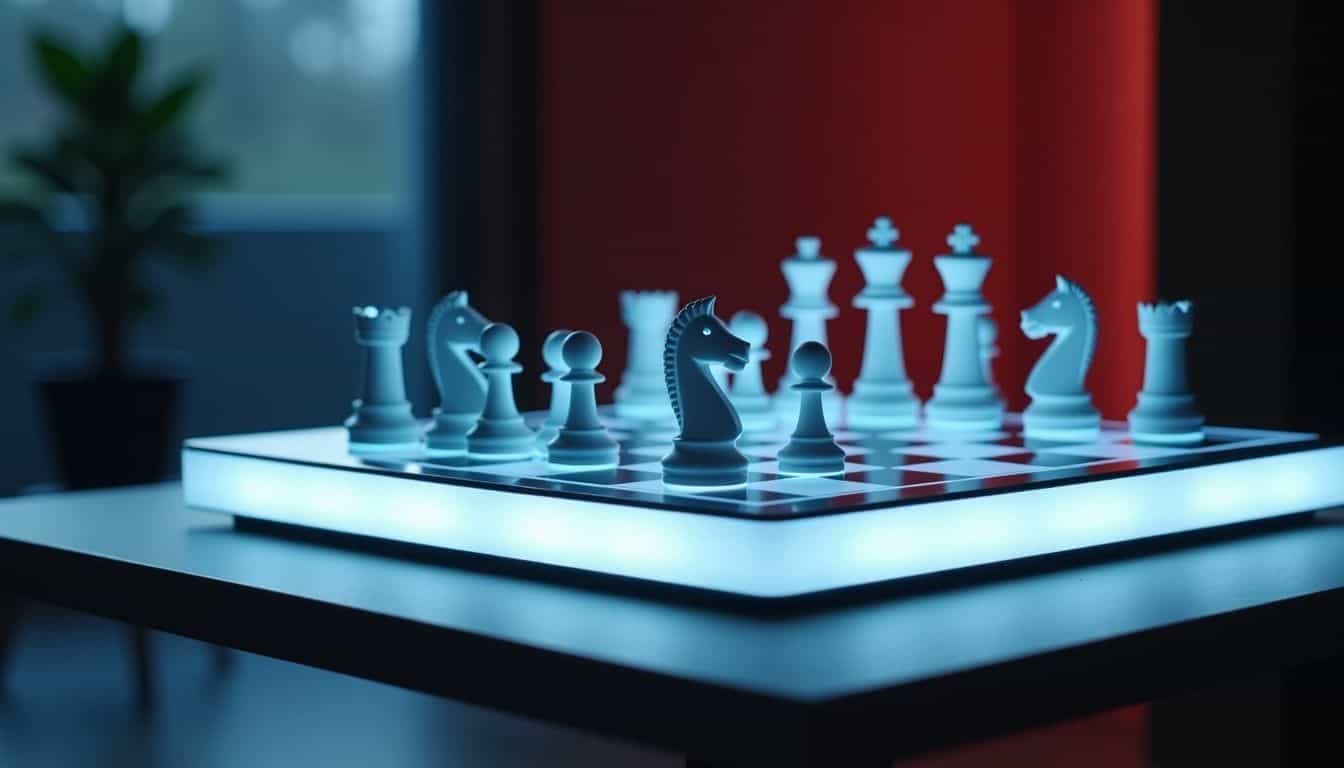
4D chess adds a whole new layer to the classic game with its extra dimension of play. The pieces move through time as well as space, creating a mind-bending challenge that forces players to think beyond the standard board.
Board setup and structure
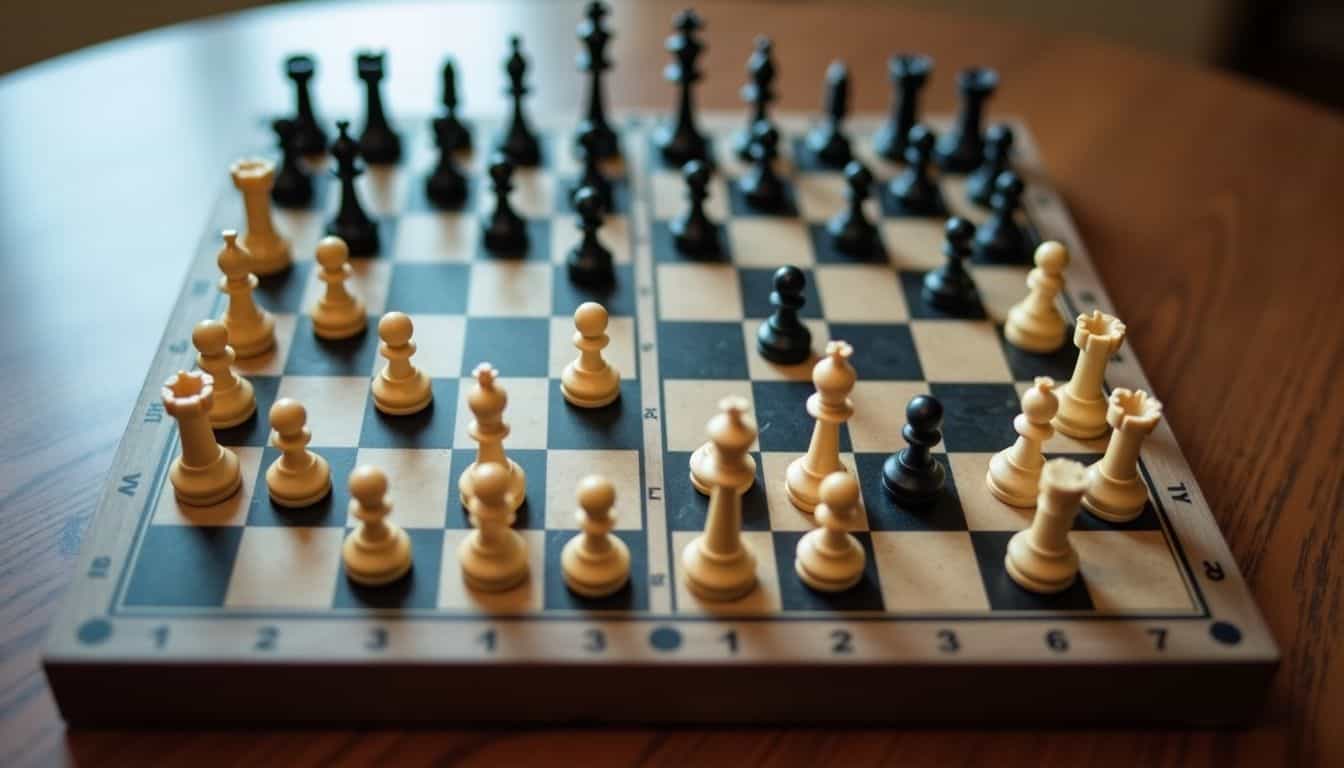
The 4D chess board might surprise you—it looks very different from regular chess. It has sixteen mini-boards, each 4×4 squares, set into a large grid of four rows and four columns.
Each mini-board connects to others in unique ways, letting pieces move through an extra dimension. Unlike the usual 8×8 chessboard, this arrangement lets pieces travel smoothly across multiple layers—a bit like moving through floors of a building.
Some enthusiasts prefer using a full 16×16 board, similar in size to a Scrabble set, known as the full 4*Chess game. A bigger board like this helps you clearly see and track positions across every dimension.
All standard chess pieces—pawns, knights, bishops, rooks, queen, and king—now exist within this expanded, multi-level playing area. This added dimension makes each move trickier, forcing players to think differently and strategize in new ways.
Movement of pieces in four dimensions

Let’s get familiar with how pieces move in 4D chess—the rules are wild but pretty easy once you get the basics:
- Queens can move in as many as 80 directions instead of the usual 8, giving them incredible range and power across four dimensions.
- Knights leap freely into the fourth dimension, skipping right past obstacles they’d normally face in 3D chess.
- Special new pieces add some fun twists—like the Balloon (D), which rises vertically through dimensional levels, or the Unicorn (U), which cuts diagonally through different dimensions.
- Pawns still advance forward, but can now shift upward or downward between dimensional layers during pawn promotions, adding more tactical options.
- Rooks keep their straight-line movements—but now include moving along the extra dimensional axis, greatly expanding their reach.
- Bishops slide diagonally through all four dimensions, opening up tricky attack paths you won’t expect on a typical chessboard.
- Kings can step one space in every dimensional direction, giving them a bit more freedom to dodge threats compared to standard chess.
- Castling happens across dimensions too, meaning your king can relocate to safety through moves impossible on a regular board.
- Pieces attack through the fourth dimension, creating threats from surprising and hidden angles compared to ordinary gameplay.
- Checkmate occurs if the king can’t move freely in any dimension at all, making late-game situations far trickier and more interesting.
Rules and gameplay mechanics
4D Chess takes regular chess and adds an extra dimension—quite literally. Instead of sticking to the usual three dimensions, it moves into a fourth spatial level, creating entirely fresh challenges for players. Here’s how it works, keeping things easy and clear:
- Pieces move across multiple 3D boards, connected by the fourth dimension—kind of like how a knight in regular chess hops over other pieces.
- Pawns step forward one space in any positive direction and capture diagonally, just as in regular chess.
- Pawns get promoted once they reach the opponent’s corner mini-board, turning into more powerful pieces.
- Knights still move in their familiar L-shaped pattern across any two directions—but tracking them in 4D becomes extra tricky.
- Bishops slide diagonally across any two dimensions, giving them a much wider range compared to traditional chess.
- Rooks move straight across each dimension and remain powerful attackers from long distances.
- The queen can combine rook- and bishop-style movements, making her the most flexible piece in this 4D version.
- The king keeps his central role, needing protection from checkmate across all dimensions.
- The special en passant capture still works—but it gets a bit trickier with another dimension mixed in.
- Stalemate, three-fold repetition, and the fifty-move rule can all still cause a draw, same as standard chess.
- Playing with virtual reality headsets, equipped with Nvidia GeForce or AMD Ryzen processors, can make visualizing the game board much clearer.
Over time, enthusiasts have created several different variations of 4D Chess—each with unique twists and challenges.
Variations of 4D Chess

4D chess comes in many forms, from basic models to complex digital versions. Players can try the classic setup with its layered boards, or explore modern computer games that render all four dimensions on screen.
Traditional 4D chess setup
Traditional 4D chess involves eight separate chessboards, each measuring 8×8 squares—stacked together like layers in a cube. Each board works the same way regular chess does, pieces and all.
But here’s what’s special: pieces can shift vertically, moving between the stacked boards through what’s called the fourth dimension.
At the start, each board has pawns placed on the second and seventh ranks, exactly like regular chess. Other pieces—including rooks, knights, bishops, a queen, and the king—take their familiar spots behind them.
Players track all their pieces across every board at the same time. Moves unique to 4D chess include “vertical castling“—letting the king and rook shift together from one board layer to another.
Because of the added layers, the possible moves multiply into billions—you can quickly find yourself in completely new situations every time you play.
Modern digital adaptations
Digital tools have transformed 4D chess, bringing it to life in ways physical boards simply couldn’t. Apps such as 4*Chess now easily track legal moves and pinpoint checkmate scenarios for you.
These programs simplify complex calculations involved in fourth-dimensional chess—something most human minds would struggle to manage alone. Game developers have released versions for Windows 10 and SteamVR, making multi-dimensional chess accessible to gamers everywhere.
Some editions even work smoothly with powerful graphics cards such as Nvidia’s GeForce GTX970, ensuring sharp visuals on the detailed chessboards.
Thanks to the internet, vibrant communities now gather around different types of 4D chess. Online sites provide tutorials on specialized chess notation, so you can accurately follow bishops, knights, and pawns across multiple dimensions.
Visual aids built into these digital games clearly illustrate complicated moves, like those made by rooks and queens across the extra dimension. Many platforms let you compete against AI opponents programmed at different skill levels, allowing beginners to ease into the game while still challenging seasoned chess players.
The Meaning of “4D Chess” in Popular Culture

The term “4D Chess” has become a popular way to describe complex political strategies that seem to work on multiple levels at once. People use this phrase to suggest someone is thinking several moves ahead of their opponents, often with hidden plans that only make sense later.
Political metaphor
“Playing 4D chess” pops up frequently in political conversations today. People toss around this phrase to describe highly strategic thinking—moves that seem to work on several levels at once.
It really caught on during Donald Trump’s presidency, as his fans argued that his puzzling actions were secretly part of a genius master plan. Critics, on the other hand, often used it sarcastically, poking fun at moves they believed were random or poorly planned.
I’ve seen countless arguments online about this, with people debating if a politician’s controversial choice was a mistake or something deeper than most people understand.
Chess already symbolizes careful strategy, so adding another dimension implies a nearly incredible level of foresight. Just as players keep their king safe from enemy knights and bishops, politicians shield themselves against attacks from all sides.
This comparison clicks especially well with geeks, who enjoy both gaming strategies and politics. It fits the way Elon Musk tackles tough business challenges, too—using layered thinking to plan ahead and outsmart his competition.
Strategic thinking and foresight
Outside of politics, “4D chess” usually refers to top-tier strategic planning—thinking far ahead and anticipating future moves. This skill lets players uncover hidden paths to success that others fail to see.
I’ve often watched chess champions dissect games, planning up to ten moves in advance. To me, the traps and chances they spotted seemed totally invisible. The greatest players don’t simply respond to their opponents—they set detailed plans in motion that corner rivals into losing positions.
Chess tactics can reflect real-world solutions, too. Donald Trump’s campaign strategy, for instance, appeared random at times, yet each move had underlying intentions revealed later on.
Even chess pieces hold valuable lessons: knights maneuver around obstacles, while bishops glide across angles, showing players how to approach problems in different and creative ways.
Businesses can also use this ability for spotting future market trends—turning small advantages into major gains through timing and smart placement. The rook, with its straightforward moves, contrasts clearly with the bishop’s angled path, demonstrating multiple methods to tackle any given problem.
Cognitive and Academic Benefits of Chess
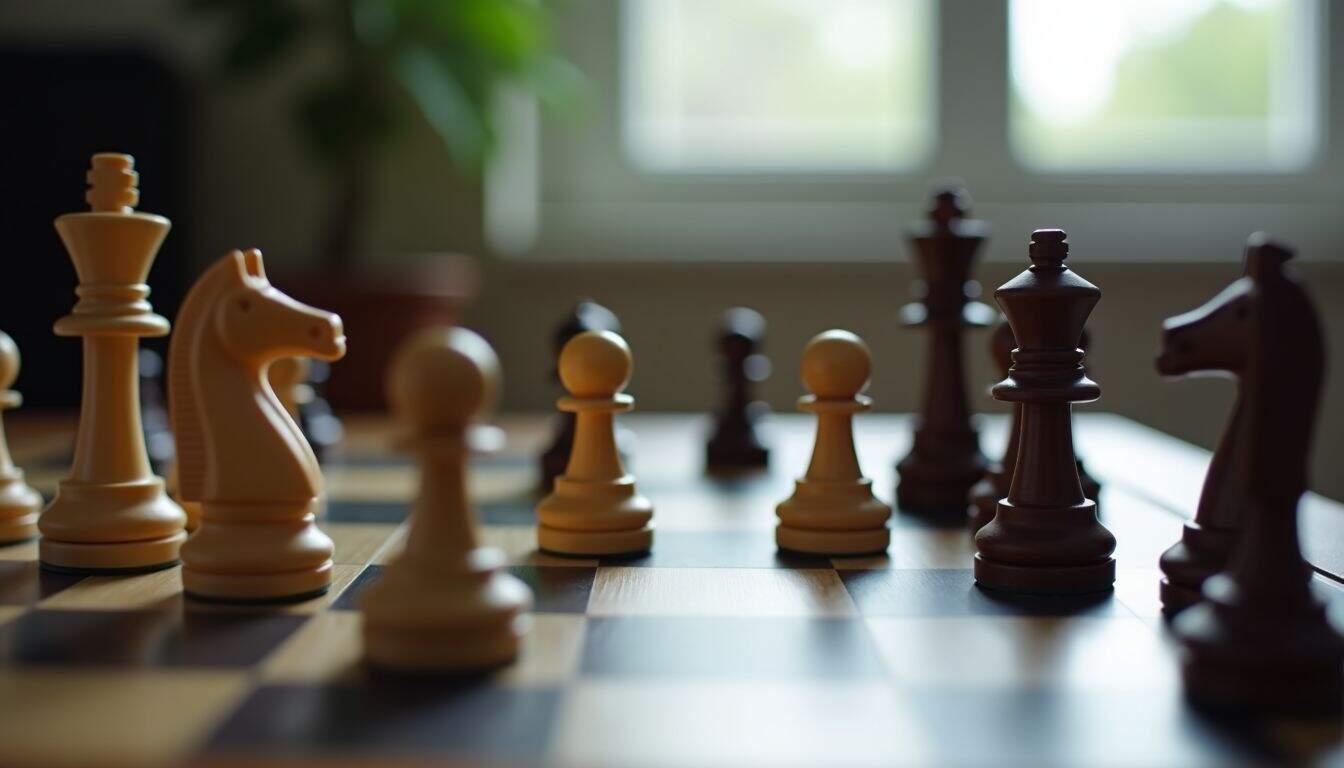
Chess builds brain power in ways few other games can match. Research shows chess players score higher on math tests and have better memory skills than their peers.
Chess as a tool for cognitive development
Research confirms chess can boost your brain power in impressive ways. Regular players think quicker, plan smarter, and recall details better as they get good at the game. I’ve seen it myself—after teaching my nephew chess weekly for three months, he improved noticeably at solving math problems.
Mastering pieces—like rooks, bishops, and knights—helps your mind recognize patterns and look a few steps ahead. Keeping track of several chess pieces, while predicting your opponent’s next move, gives your brain a real workout.
It’s like training your mind for everyday situations that require quick thinking and planning ahead.
Kids who start chess early gain big cognitive benefits. Research connects chess practice at a young age to clear improvements in school performance and general thinking skills. Even seemingly basic pieces, like pawns, teach kids patience and how to concentrate.
After practicing chess endgames consistently, my students did much better on logic-related school tests.
The queen, able to zip across the board in nearly any direction, encourages flexible thinking and creative problem-solving. Protecting the king, which moves slowly and needs careful defending, builds strategic thinking skills.
Those abilities carry over naturally into day-to-day activities—especially where smart planning and good decision-making count.
Transferable skills from chess to real life
Chess builds skills you can use every day—in life, school, and even work. Players learn to plan ahead, predict outcomes, and consider what comes next. It’s like planning a work project or mapping out your family’s monthly budget.
The game challenges you to examine problems from multiple angles, helping solve tricky situations at work or school. Chess teaches patience and focus, which can really help during long meetings or difficult tasks.
Studies have linked chess directly to higher math scores and stronger academic performance. The mental practice of moving knights and bishops trains the brain to spot patterns and think logically about real-life events.
Beyond thinking skills, chess also offers lessons on actions and consequences. Every pawn or rook has its purpose—one move can change your whole game—so players learn to take responsibility for their decisions.
This kind of training helps people make smarter choices at home, in friendships, or on the job. The game also builds mental strength; losing your queen feels terrible, sure, but skilled players use mistakes as stepping stones, not setbacks.
This kind of perseverance gives people the level head needed to face real-life challenges calmly. Many chess enthusiasts value these personal growth lessons far above simply winning matches.
Tips for Playing 4D Chess
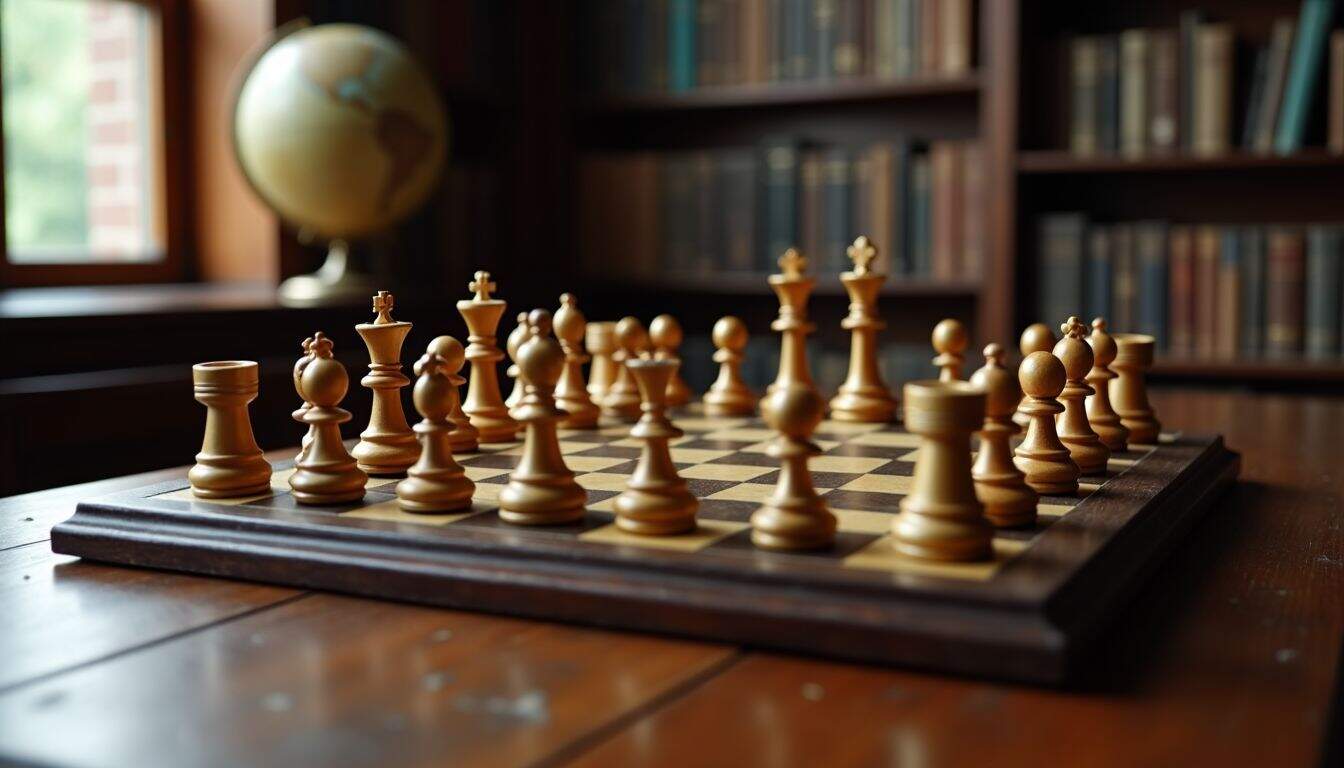
To play 4D chess well, you must train your brain to think beyond the limits of our 3D world. Start with basic moves of chess pawns and chess knights on a standard board, then add the fourth dimension slowly as you build mental strength.
Understanding the fourth dimension
The fourth dimension goes beyond normal height, width, and depth. In 4D chess, this extra dimension gives chess pieces entirely new movement options. Imagine a rook moving through hidden passageways—connecting boards in new ways.
Players must manage bishops smoothly across more than a simple, flat board. Instead, the game unfolds across 16 separate smaller boards arranged into a hypercube. With this unique setup, even knights leap into squares impossible to describe in standard chess notation.
The experience pushes your brain to imagine moves along an unseen axis—a bit like 3D chess opens vertical paths.
Our brains aren’t naturally wired to picture four-dimensional spaces, but with practice, we can adapt. Computer graphics supported by Intel processors and Nvidia GeForce GTX970 make complex boards easier to view and play.
In 4D chess, even the queen gains impressive new powers, striking pieces once considered safe from attack. Most beginners pick a single pawn, mastering its movements first, before taking on the entire game.
The idea might sound strange—like playing checkmate backward—but it introduces fresh ways to approach space, strategy, and creativity beyond chess itself.
Developing strategies for multi-dimensional gameplay
Winning at 4D chess means mastering vertical boards. You need to look beyond flat movements and see opportunities across layers. In this game, queens and rooks quickly become strong pieces because their moves can cross multiple dimensions.
Skilled players aim for spots that limit the other player’s choices—like controlling passed pawns in regular chess—but with extra layers to consider.
Regular practice sharpens your 4D skills. New players often have trouble visualizing moves through different boards, similar to learning circular or 3D chess. Consistent analysis helps you spot familiar patterns across various planes.
Modern digital chess versions—unlike older software such as Internet Explorer 8—include helpful visual guides, making it easier to understand complex moves. Top players blend classic bishop moves with fresh strategies that use the extra dimension effectively.
Steady practice keeps your game sharp and lets you catch your opponent off guard—opening doors to clever, unexpected plays.
Does 4D Chess Really Exist?

4D chess exists more as a concept than a physical game you can buy at the store. Real players use computer programs to try this brain-twisting version, while sci-fi shows like Star Trek feature their own take with tri-dimensional chess boards.
Real-world applications and adaptations
Different chess groups have built actual, physical sets for playing 4D chess. These special boards use layers and distinct colors to represent the extra fourth dimension. The best-known set, called Slim 4*Chess, has 80 playing pieces and keeps the rules similar to standard 4*Chess.
Players have to follow pieces across multiple levels—something that’s far more challenging compared to normal chess.
Online versions are gaining popularity, too. Today, updated computer software helps players by clearly marking legal moves across every dimension. Certain programs even allow users to rotate the gameboard, making it easier to spot moves available to specific chess pieces, such as rooks or bishops.
Gaming companies, including Valve Corporation, have started experimenting with bringing 4D chess onto their platforms—but these projects are still mainly in testing stages.
Theoretical vs. practical gameplay
4D chess mostly lives as an idea, rather than a game people actually play. Adding an extra dimension creates rules that standard chessboards can’t easily handle. In reality, computer programs such as Kevin Pacey’s 4*Chess step in to help by tracking possible moves and spotting checkmates.
I gave it a shot recently, playing against a buddy using the 4*Chess system Kevin developed. Turns out, some basics still hold true—pairing up a king and queen, for instance, easily beats a lonely king, just like normal chess.
Rooks and bishops become surprisingly powerful in four dimensions. The added layers of play make each move feel exciting and challenging. But honestly, keeping track of all those positions gets tricky quickly.
Most human brains don’t naturally see moves spread across four dimensions, so digital programs are almost always necessary. For fans of chess and puzzles alike, the idea of playing 4D chess feels fascinating and fresh.
Still, to really enjoy it, you’d better have some trusty software handy—just to keep your head from spinning.
How Will 4D Chess Evolve in 2025?

March 2025 will mark an exciting development for fans of 4D chess—Makruk, or Thai Chess, will debut as a special featured variant. This fresh version, designed by Kevin Pacey, should boost the game’s worldwide popularity even more.
Players will tackle 4*4*Chess on a flat, two-dimensional surface made up of sixteen smaller boards, each 4×4, combining to form a large 16×16 board. Alongside familiar chess pieces like kings, queens, and rooks, the game includes new, creative figures such as the Balloon, Unicorn, and Dirigible.
The piece-value system adds surprising variety and balance to the game. Pawns count for exactly 1 point, while Dirigibles are slightly stronger at 1.2. Rooks remain steady at 3 points, and bishops, unicorns, and knights each rate evenly at 3.4.
Queens dominate at an impressive 16 points, while kings hold firm at a value of 10. Due to these varied values and board structures, computers have a tough time analyzing 4D Chess positions, allowing human experts to keep an advantage over chess engines.
Its strategic depth is impressive enough to earn a solid 21 out of 36 rating—this evaluation, based on nine different strategic measures, ensures rich gameplay with plenty of challenges for even seasoned chess enthusiasts.
People Also Ask
What exactly is 4D chess, and how does it differ from normal chess?
4D chess takes regular chess and adds another dimension: time. Pieces don’t just move around the chessboard—they move across different moments as well. Unlike traditional chess, where kings, queens, and rooks only slide around a flat surface, the pieces here can hop from one time to another. This makes moves trickier to picture clearly, giving your brain a bigger challenge.
Does a chess bishop move differently in 4D chess?
Yes, the bishop gets special new moves in 4D chess. It keeps its familiar diagonal move but can now also shift across points in time. These extra moves make the bishop a much bigger threat compared to its regular chess counterpart.
Is 4D chess actually a real game?
Yes, 4D chess is technically real but mainly exists as an idea or concept. People don’t play it as much as normal chess. It falls in the same family as other chess spin-offs, like circular chess or bughouse, which twist and tweak the standard game rules.
How do you know you’re checkmated in a game of 4D chess?
In 4D chess, checkmate happens once your king is trapped with no safe moves left, in any dimension, including time. The king can normally escape by moving across the board or jumping through the timeline—but if every possible move is unsafe, you’re checkmated. Figuring this out can get tricky quickly, since you need to consider multiple times and places, not just a flat board.
References
https://womenwellnesswork.ursuline.edu/what-is-4d-chess
https://www.chessvariants.com/rules/4chess-four-dimensional-chess
https://staging.datascience.northwestern.edu/ultimate-guide-4d-chess-strategies-now
https://www.slowboring.com/p/how-were-thinking-about-covering/comments (2025-02-25)
https://www.healthline.com/health/benefits-of-playing-chess (2020-10-19)
http://math.iit.edu/~breiniger/Chess/chess-basicmath.pdf
https://www.chess.com/forum/view/general/4d-chess-2018-11-04
https://shrine-dev-node02.catalyst.harvard.edu/1-uncover-the-ultimate-4d-chess-strategies-now (2025-02-23)
